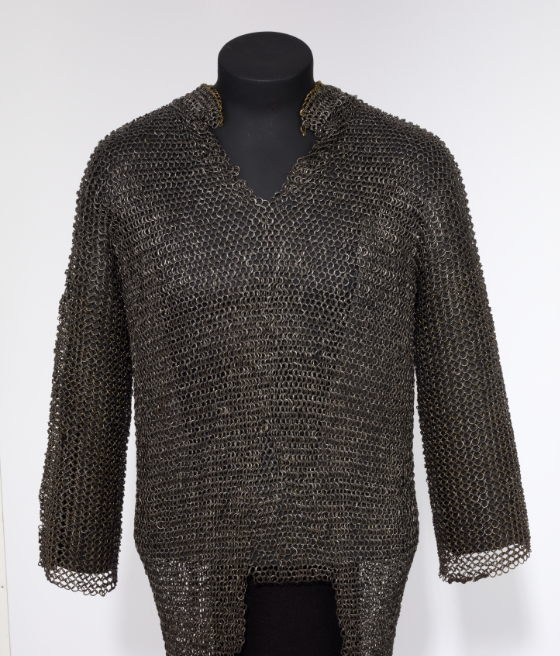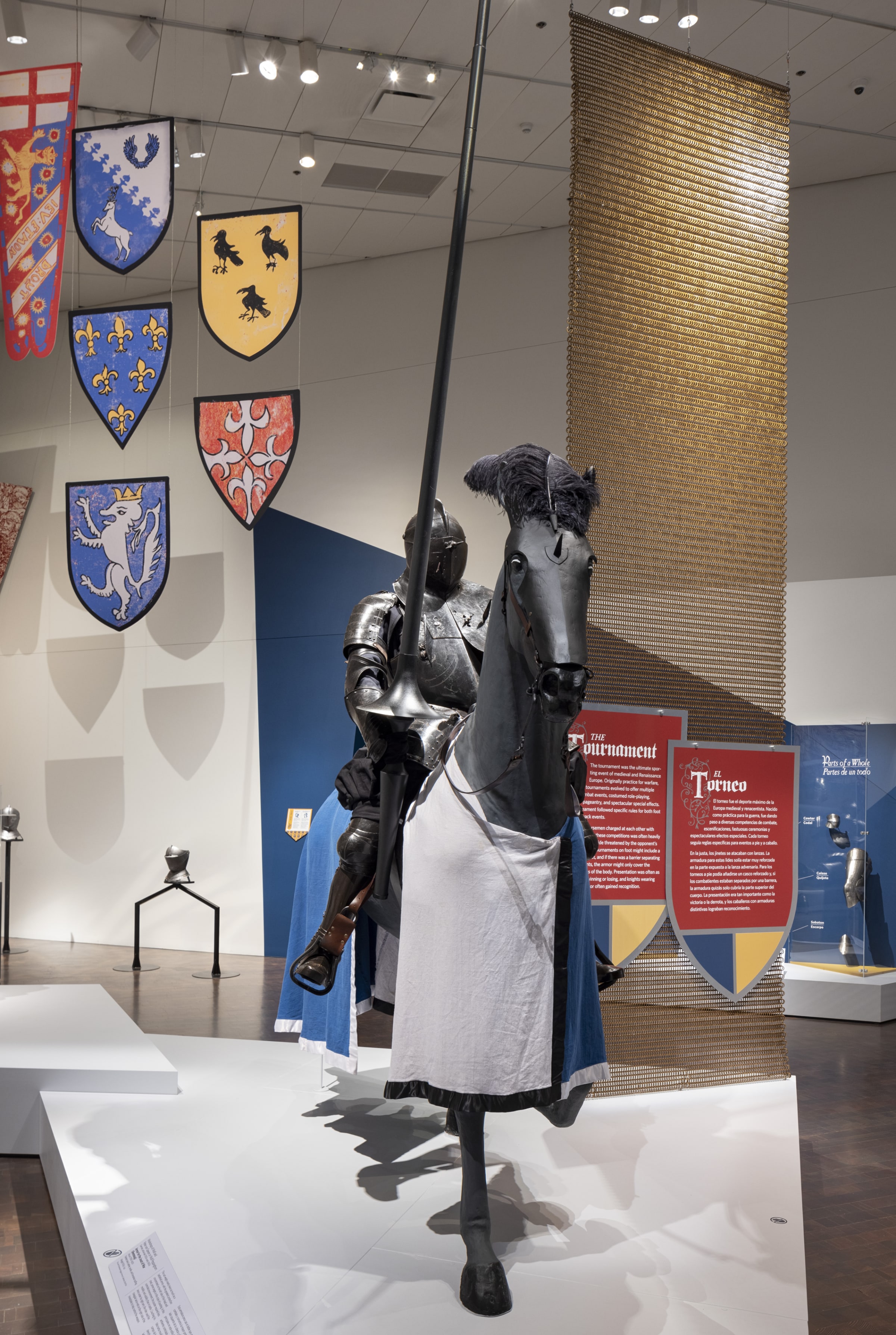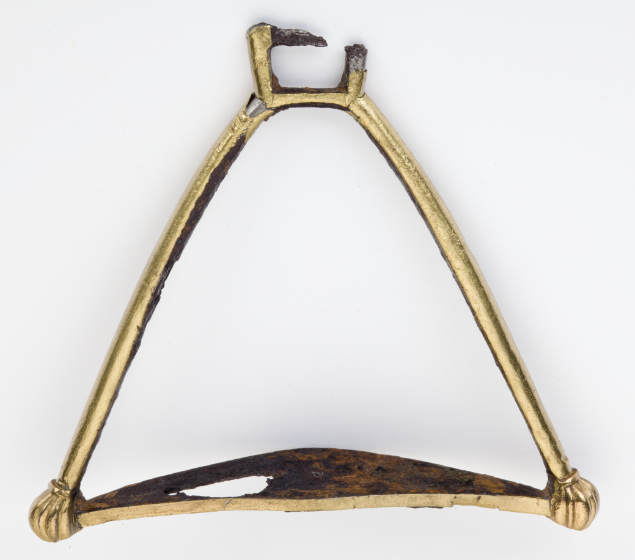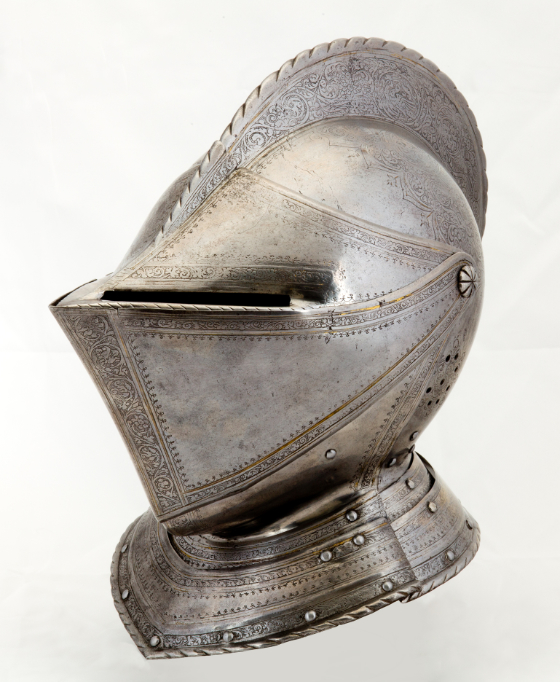While armor often conveyed status and sophistication, its basic purpose was to protect the wearer. The evolution of armor was driven by the changing conditions of warfare, various forms of martial sports like jousting, and the development of metalworking technology.
Knights and other soldiers demonstrated their prowess, made their fortunes, and often lost their lives in battles and tournaments. Armor was designed to withstand the threats of a specific environment. Battlefield armor varied depending on a soldier’s role in combat, and allowed them to move and fight effectively in unpredictable circumstances, while tournament armor might be heavier and only cover areas exposed in a specific event.
The Battlefield
The well-armored soldier of the early Middle Ages wore a helmet made of steel plates and a flexible coat of mail made of thousands of interlocking rings. Improvements in metalworking in the 1300s made it possible to forge larger sheets of steel, which artisans fashioned into armor plates that gradually came to cover the entire body as an articulated suit. The continuous development of weaponry also fueled armor’s evolution.
Battlefield armor struck a balance between mobility and protection. While a full suit of field armor might weigh 50 to 60 pounds, it still allowed the wearer to be quite nimble.
Ancient Weapons
Crescentic Axe Blade
Egypt, Middle Kingdom
About 2000–1750 BCE
Bronze
Weight 14 oz.
The John Woodman Higgins Armory Collection, 2014.611
Image © 2021 Worcester Art Museum, all rights reserved
Solid-Hilted Sword
Probably central Europe
About 1400–1200 BCE
Bronze
Weight 1 lb. 13 oz.
The John Woodman Higgins Armory Collection, 2014.351
Image © 2021 Worcester Art Museum, all rights reserved
Winged Spearhead
Frankish culture, Germany
About 900–1000
Steel
Weight 15 oz.
The John Woodman Higgins Armory Collection, 2014.674
Image © 2021 Worcester Art Museum, all rights reserved
These weapons represent types used by warriors of the distant past. Both the axe and sword are made of bronze, a metal used for thousands of years before the use of iron and steel (a stronger form of iron with higher carbon content). Bronze is more brittle than iron, so weapons were made relatively short and thick to avoid breaking. The use of steel allowed for more durable weapons like the later spearhead, which became the precursor to the knight’s lance.
The Steed
Shaffron (Horse’s Head Armor)
Augsburg, southern Germany
About 1560
Etched and gilded steel, brass, and leather
Weight 3 lb. 14 oz.
The John Woodman Higgins Armory Collection, 2014.10.1.1
Image © 2021 Worcester Art Museum, all rights reserved
Stirrup
Possibly England
1100s–1200s
Brass-clad iron
Weight 12 oz.
The John Woodman Higgins Armory Collection, 2014.1008
Image © 2021 Worcester Art Museum, all rights reserved
Horsemanship was an essential skill for knights, whose original purpose was to serve as mounted warriors. In fact, the word “chivalry” comes from the French word for horse—cheval. Stirrups came to Europe around 700 from central Asian tribes and helped the mounted knight dominate the medieval battlefield. This etched and gilded shaffron, which protected the horse’s head, was made in the German city of Augsburg, an important center for armor making.

Halberd
Italy
About 1540
Steel and wood
Weight 3 lb. 12 oz.
The John Woodman Higgins Armory Collection, 2014.137
Rondel Dagger
Nuremberg, Germany
About 1400–50
Steel, copper alloy, and bone
Weight 11 oz.
Higgins Collection Acquisition Fund, funds by deaccession from the John Woodman Higgins Armory Collection, and the Sarah C. Garver Fund, 2018.3
Broadsword
Western Europe (hilt possibly England)
1400–50
Steel with traces of organic materials
Weight 3 lb. 8 oz.
The John Woodman Higgins Armory Collection, 2014.56
In addition to his lance, the knight carried a sword as an all-purpose weapon. The diamond-shaped cross-section helped stiffen this blade, which was designed to penetrate the gaps in a suit of armor and break open the links of mail armor (metal rings linked together to form mesh) underneath.
This sword comes from an important cache excavated in 1972 from the Dordogne River, in France. It was lost in 1453 by the retreating English forces after Castillon, the final battle of the Hundred Years’ War.

Group of Six Crossbow Bolts
Probably Germany
Early 1500s
Steel, wood, and leather
Weight 2.5 oz. each
The John Woodman Higgins Armory Collection, 2014.686.1-6
Quiver for Crossbow Bolts
Austria
Late 1400s–early 1500s
Leather, animal pelt, wood, and glue
Weight 1 lb. 4 oz.
The John Woodman Higgins Armory Collection, 2014.622
Ulrich Wildisen
Swiss, active in Stein-am-Rhein/Schaffhausen, mid-1500s
Cranequin (Crossbow Winder)
About 1550
Steel, brass, copper inlay, bone or horn, and walnut wood
Weight 4 lb. 1 oz.
The John Woodman Higgins Armory Collection, 2014.581
The development and evolution of weaponry continually challenged armorers. The crossbow presented one serious threat. These were simple “point-and-shoot” weapons that even minimally trained soldiers could employ effectively.
Mechanical devices like the cranequin were used to draw the crossbow, allowing it to deliver more power than bows drawn by human strength alone. The crossbow bolts have stout steel heads, and artisans developed plate armor with glancing surfaces to prevent the bolts from penetrating.

Basinet Helm with Aventail (Mail Hood) and “Dog-Faced” Visor
Probably Germany
About 1360–70
Steel, and brass with modern leather and cord restorations
Weight 6 lb. 2 oz.
The John Woodman Higgins Armory Collection, 2014.842.1
Image © 2021 Worcester Art Museum, all rights reserved
This helmet is typical of the style worn by knights from the late 1300s to the early 1400s. Although it has been heavily restored and combines elements from two separate helmets, the pieces are all authentic. It remains a rare survivor of an important armor type. The so-called dog-faced visor deflected enemy weapons but also made the wearer appear more threatening.

Mail Coat
Probably Nuremberg, Germany
Early 1500s, modified in the 1800s
Steel and brass with leather fragments
Weight 17 lb. 10 oz.
The John Woodman Higgins Armory Collection, 2014.861
Image © 2021 Worcester Art Museum, all rights reserved
Mail, popularly known as “chainmail,” is made from tens of thousands of steel links, each individually riveted or welded shut. Originally made as a hip-length shirt, this rare example was later exported to the Ottoman Empire as military surplus. It probably ended its working life in northern Africa in the late 1800s, where someone lengthened it to protect the legs. This style, slit up to the groin so it could be worn on horseback, is similar to what medieval knights wore before plate armor.

Pauldron for the Right Shoulder
Possibly Innsbruck or Mühlau, Austria
About 1490
Steel and leather
Weight 2 lb. 7 oz.
The John Woodman Higgins Armory Collection, 2014.1146.4
Mail Sleeve
Europe
Probably early 1500s
Steel and brass
Weight 3 lb. 10 oz.
The John Woodman Higgins Armory Collection, 2014.858.2
Cowter for the Left Elbow
Probably Spain
1490–1500
Steel
Weight 6 oz.
The John Woodman Higgins Armory Collection, 2014.808
Mitten Gauntlet
Germany or Austria
1540–60
Steel
Weight 1 lb. 6 oz.
The John Woodman Higgins Armory Collection, 2014.573
Cuisse for the Left Leg
Milan, Italy
1450–90, with restorations from 1925
Steel and leather
Weight 3 lb. 4 oz.
The John Woodman Higgins Armory Collection, 2014.842.5
Poleyn for the Right Knee
Probably Italy
About 1400–20
Steel
Weight 1 lb. 1 oz.
The John Woodman Higgins Armory Collection, 2014.909
Sabaton for the Left Foot
Germany
About 1490
Steel and leather
Weight 7 oz.
The John Woodman Higgins Armory Collection, 2014.1153.7
It’s a modern misconception that knights could barely move in their armor. While weighty, a suit consisted of several pieces expertly crafted to fit the human form, with overlapping plates that covered the wearer, allowing for great flexibility and mobility. These were laced to the knight’s padded arming jacket, which secured the pieces to his body and supported their weight. Components included:
Pauldron: This provided protection for a knight’s shoulder and armpit. You are looking at the back—the large wing over the shoulder blade prevented gapping when the knight raised his arm.
Mail Sleeve: Knights wore mail underneath plate armor to protect the gaps at vulnerable joints.
Cowter: Also called an “elbow cop,” the cowter overlapped plates of the upper and lower arm.
Gauntlet: Gauntlets came in two basic versions—glove and mitten. Gauntlets originally had leather gloves stitched inside, but those rarely survive.
Cuisse and Poleyn: The cuisse protected the knight’s thigh, while the poleyn covered the knee. These were often joined together. Wings at the side of the poleyn protected the back of the knee while allowing it to bend.
Sabaton: The sabaton, armor for a knight’s foot, echoed the shape of a medieval shoe. Armor of the time often mimicked the latest fashions.
The Tournament
The tournament was the ultimate sporting event of medieval and Renaissance Europe. Originally practice for warfare, tournaments evolved to offer multiple combat events, costumed role-playing, elaborate pageantry, and spectacular special effects. Each tournament followed specific rules for both foot and horseback events.
In the joust, horsemen charged at each other with lances. Armor for these competitions was often heavily reinforced on the side threatened by the opponent’s lance. Armor for tournaments on foot might include a reinforced helmet, and if there was a barrier separating the combatants, the armor might only cover the upper portions of the body. Presentation was often as important as winning or losing, and knights wearing distinctive armor often gained recognition.

Workshops of Wolf and Peter von Speyer or Wolf Peppinghorn
German, active late 1500s–early 1600s
Armor for the Joust of War (Rennzeug)
About 1590–1600
Painted steel, leather, textile, and horsehair stuffing
Weight 93 lb. 1 oz.
The John Woodman Higgins Armory Collection 2014.1154
This suit weighs nearly twice as much as a battlefield armor, with the greatest protection concentrated on the left side of the head and chest, prime targets in this style of jousting. In this controlled environment, the jouster required less mobility and visibility than in battle. Couching his lance under his right arm, the rider used the triangular lance-rest on the right side of the breastplate to help control the weapon.
Armor for the Joust over the Tilt (Plankengestech)
Northern Germany
1550–75
Steel and brass with modern leather restorations
Weight 64 lb. 6 oz.
The John Woodman Higgins Armory Collection, 2014.79.1
Image © 2021 Worcester Art Museum, all rights reserved
This ornate, Italian-influenced armor was designed for jousting over the tilt. The tilt was a wooden barrier between the jousters, preventing their horses from colliding when they charged at one another, and inspiring the term “full-tilt.” The shoulder, neck, and head defenses are bolted together for increased protection. The trelliswork on the left shoulder helped catch the tip of the opponent’s lance, increasing the chances of dramatically shattering it to entertain the audience.
Head Protection
Close Helmet for the Foot Tourney
Augsburg, southern Germany
About 1590
Etched and gilded steel and brass
Weight 11 lb. 15 oz.
The John Woodman Higgins Armory Collection, 2014.1113
Image © 2021 Worcester Art Museum, all rights reserved
Close Helmet for Foot Combat at the Barriers
Probably Milan, Italy
About 1600
Steel and brass
Weight 9 lb. 15 oz.
The John Woodman Higgins Armory Collection, 2014.1156.1
Image © 2021 Worcester Art Museum, all rights reserved
Both of these helmets were designed for tournament combat in which the opponents fought on foot from opposite sides of a wooden partition. In this scenario, the head was naturally a prime target, so these helmets are unusually heavy, made of thick steel for maximum protection. On the less decorated helmet, look for the marks of sword blows on its left side, where attacks landed.
Attributed to Kolman Helmschmid
German, 1471–1532, active in Augsburg
Reinforcing Breastplate and Left Tasset for the Joust
1520–25
Etched steel and brass with modern leather
Breastplate 6 lb. 4 oz.
Tasset 2 lb. 12 oz.
The John Woodman Higgins Armory Collection, 2014.1138.3, 2014.1138.7
Image © 2021 Worcester Art Museum, all rights reserved
Reinforce for the Left Shoulder (not pictured)
Probably Germany
Late 1400s
Steel
Weight 3 lb. 13 oz.
The John Woodman Higgins Armory Collection, 2014.1138.8
Vamplate (Handguard for a Lance) (not pictured)
Probably Germany
1575–1600
Iron, brass, and leather
Weight 1 lb. 9 oz.
The John Woodman Higgins Armory Collection, 2014.969
Close Helmet for Field and Tournament
Milan, northern Italy
About 1550–70
Etched steel with traces of gilding
Weight 8 lb.
The John Woodman Higgins Armory Collection, 2014.1124
Image © 2021 Worcester Art Museum, all rights reserved
This helmet was designed for use in both combat and tournaments, situations where lances were a danger. While the narrow eye slot limited the wearer’s vision, it helped to prevent a spearpoint from entering. The armorer shaped the front of the helmet to deflect an opponent’s lance.

Age of Armor: Treasures from the Higgins Collection at the Worcester Art Museum is organized by the Worcester Art Museum. Support is provided by the donors to the Annual Fund Leadership Campaign and the residents who support the Scientific and Cultural Facilities District (SCFD). Promotional support is provided by 5280 Magazine and CBS4.










